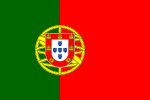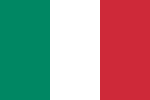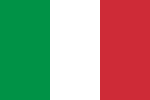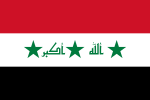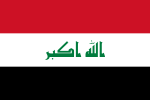Flag dispute

A flag dispute or flag war is a controversy about the use or symbolism of a flag that is extremely violent. Sometimes this is even referred to as a “symbolic publicist civil war”. The reasons for the dispute are mostly political and / or ideological. Especially in times of political upheaval, in which the national symbols often undergo a change, these are usually bitterly disputed.
Deviating from this, a flag dispute can also mean the conflict about the national flag to be set on a certain territory in order to reinforce the ownership claims of a state. An example of this would be the flag dispute between the United States and Panama in 1964 or the conflict between Canada and Denmark over Hans Island .
Historical examples
Germany: Weimar Republic
With the change from black, white and red in the German Empire to black, red and gold in the Weimar Republic , there were constant discussions about the German national colors. In addition to parliamentary and public discussions, the dispute even led to street fights between the opposing camps. The monarchists and National Socialists favored the reintroduction of the old flag and ridiculed the new flag as "black-red mustard". The opponents of the imperial colors replied with "Black and white red, Manneken is dead, black and red gold, the maiden, she is lovely."
In 1926, the Luther II cabinet even failed because of the flag dispute. On May 5, 1926, Luther ordered that the empire's embassy and consular authorities in non-European countries should in future place the black, red and gold national flag and the black, white and red trade flag (with the black, red and gold upper corner) next to each other . In the heated debates that followed, both in public and in the Reichstag on May 12, 1926 , Luther was finally overthrown.
The dispute escalated to house flagging before the Reichstag election on November 6, 1932 . It came to an end with the takeover of power by the National Socialists and the provisional reintroduction of black-white-red as the national flag of Germany . Black-Red-Gold finally returned after the Second World War with the establishment of the Federal Republic of Germany (May 1949) and the GDR (October 7, 1949) .
Monarchists against Republicans in Portugal, 1910
With the proclamation of the republic on October 5, 1910 , such a violent dispute broke out over the future symbols of the country that it was later referred to as the “flag war” (A Guerra das Bandeiras) . During this time there were a multitude of different proposals for a new national flag. The primary colors were discussed. While the Republicans wanted their traditional red and green as the new colors, the monarchists clung to the old blue and white. Blue also had a religious meaning as the color of Our Lady of Conception (Nossa Senhora da Conceição) , the patron saint of Portugal, and was a thorn in the eyes of the republicans who sought the secularization of Portugal. From October 15, 1910, various drafts were discussed in a government commission. Eventually she chose the Republican Party's green and red as the colors for the new flag of Portugal . The political meaning of these colors, already used by the republican insurgents on January 31, 1891 in Porto , was hidden behind patriotic reasons.
The flag change had violent consequences in the colony of Portuguese Timor , where riots broke out. The small kings ( Liurai ) there, who exercised direct power under the sovereignty of Portugal, had received a Portuguese flag, among other things, as a symbol of the alliance, which, following the Timorese tradition , were venerated as sacred objects, from which the rulers drew their authority and strength. This sacred meaning of the blue and white flag meant that the new flag was often not adopted and the old flag of the monarchy continued to be used by the Liurais.
The exact coloring of the flag of Italy
After a reform under the right-wing Berlusconi government , the colors of the Italian flag were first precisely defined by law in 2003. Instead of the strong colors that had been used up to now, the green of the flag was now lime green, the white now slightly ivory and the red a bit paler. The opposition called this a "color coup". Berlusconi later stated that the colors used were a "technical error". On July 28, 2006, under the left-wing government of Romano Prodi , the colors were redefined as green, white and scarlet.
2: 3 ? Flag of Italy since 2006

Macedonia: The star of Vergina
In most cases, different political groups within a country argue about the representation of the national flag. When the former Yugoslav Republic of Macedonia added the star of Vergina to its red national flag in 1992 , neighboring Greece demanded that it be removed. Like the country name Macedonia, Greece regards the symbol as cultural heritage and saw in it the danger of a Macedonian claim on the northern Greek region of Macedonia . In 1995, Macedonia swapped the star in its flag for a stylized sun as a compromise. An unofficial blue flag with the star of Vergina is used in the Greek province.
Berlin Flag War 1996
Not a dispute over the design of a national flag, but the use of a symbol for homosexuality led to the so-called Berlin Flag War . At the suggestion of the former Berlin - Brandenburg Gay Association SVD (today LSVD ), the rainbow flag was hoisted for the first time in Germany in 1996 on the occasion of the Lesbian and Gay City Festival and the Christopher Street Day in Berlin at the town halls of Schöneberg , Tiergarten and Kreuzberg . The then Berlin Senator for the Interior, Jörg Schönbohm, tried unsuccessfully for several years to prevent the flag from being set in the Berlin districts with reference to the Berlin Flag Ordinance. Since Klaus Wowereit took office as Governing Mayor in 2001, he and representatives of the LSVD have hoisted the rainbow flags annually on Christopher Street Day at the Red City Hall .
Iraq flag
The then ruler of Iraq, Saddam Hussein , added the so-called Takbīr "God is great" (Allahu Akbar) to the national flag of Iraq . It is said to have been his personal writing, which is why the flag, despite its religious symbolism, came under fire after the fall of Hussein in 2003. On June 28, 2004, the font was first changed to the angular Kufic style . In addition, the Kurdish population in particular saw the three green stars in the flag, symbol of the Baath party , as a reminder of the oppression under the dictatorship. A large part of the Kurdish areas therefore set their own flag instead of the national flag.
In April 2004, the Iraqi government council presented a draft for a new national flag: a light blue crescent moon and a yellow stripe between two blue lines can be seen on a white background. The draft sparked violent protests as the pan-Arab colors disappeared from the flag. Critics also said the design would resemble the flag of Israel . Many felt the flag was a symbol of American Iraq . So it stayed with the change of the font.
Another proposal for a new national flag followed in January 2008. The text Allahu Akbar should now be in yellow instead of green. The yellow color should represent the Kurdish minority here. The meaning of the stars has been reinterpreted as peace, tolerance and justice. But even this draft was rejected by the Kurds because of the stars.
Eventually the stars were removed from the flag. The green lettering was also given a darker shade. In November 2008 a decision was to be taken on a new national flag, which should be selected from entries to a competition. But that did not happen.
2: 3 ? Flag of Iraq, 1991 to 2004


7:10 ? Flag proposal from 2004

2: 3 ? Compromise solution between 2004 and 2008 with a modified font


2: 3 ? Short-lived flag proposal in January 2008

2: 3 ? Flag of Iraq since January 2008

Raising the franc flag
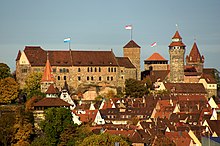
Since the day of the Franks was introduced in 2006 , Franconian politicians and initiatives have been demanding to be allowed to hoist the Franconian flag on public buildings. However, this demand was subsequently rejected by the Bavarian State Parliament on the grounds that it was not a state flag . A constitutional resolution of the state parliament in 2012, on the other hand, determined that the flag may also be displayed as an advertising medium alongside the flag of Germany , the Bavarian state flag and the European flag on state buildings.
Another dispute on this subject was the use of flags on Nuremberg Castle . The first raising of a Bavarian flag in 2008 was seen as an affront by many Nuremberg and Franconians . A request from SPD city councilors to the Free State to also hoist the Franconian flag was rejected by the then Bavarian Interior Minister Joachim Herrmann . The then Lord Mayor of Nuremberg, Ulrich Maly, defused the conflict in the summer of 2019 by raising the Nuremberg city flag . In its version without the city arms it looks very similar to the Franconian flag. The cost of the newly erected eight-meter-high flagpole amounted to 25,000 euros. After the constitutional resolution of the state parliament of 2012, the flag changed again in the summer of the same year: The German flag on the main building (Palas) was replaced by the Bavarian flag, which was previously hoisted on the Heidenturm. Since then, the Franconian flag has been flying here. The flag of Germany is now on a newly erected flagpole, which is located on the castle clearance.
Current examples
The Union Jack in national flags
The national flags of Australia , New Zealand , Tuvalu and Fiji's lead in the Gösch the Union Jack as a symbol of loyalty to the former colonial power Britain (see also: Blue Ensign ). This is rejected by parts of the respective population as a symbol of the supremacy of Great Britain. Traditional colors and symbols of the athletes of Australia and New Zealand provide templates for popular flag proposals in these countries, which are mainly used by fans at sporting events. In Australia, a widespread flag was created with a boxing, golden kangaroo ( Boxing kangaroo ), partly with the stars from the national flag in gold on a green background. A black flag with a silver fern is often found in New Zealand . There are also a number of other suggestions in both countries.
1: 2 ? Flag of Australia

 ? Union Jack by the flag of the Aboriginal replaced
? Union Jack by the flag of the Aboriginal replaced
1: 2 ? New Zealand flag

 ? red-white-blue design by Kyle Lockwood 2000
? red-white-blue design by Kyle Lockwood 2000
 ? black, white and blue design by Kyle Lockwood
? black, white and blue design by Kyle Lockwood
While the discussion in Australia has been unsuccessful for years, a national flag without a Union Jack was used in Tuvalu between 1995 and 1997, until another change of government resulted in a return to a slightly modified form of the old national flag with the Union Jack.
On March 24, 2016, the New Zealanders voted in a referendum against the introduction of the black, white and blue silver fern flag and thus for the retention of the previous national flag.
In 2015 Fiji thought about the introduction of a new national flag without a Union Jack, and drafts were collected. In 2016, however, the idea was rejected again with reference to the high costs of changing flags.
In Canada , the old flag with the Union Jack was finally replaced by a new national flag in 1965 . It was mainly the francophone population (around 23% of Canadians, over 80% in Québec ) who protested against the Union Jack. However, there are still some who were bothered by the red and white coloring, which they consider to be too English . They continue to demand a visible symbol for the French-speaking population, for example by including blue in the national flag (based on the Bleu-Blanc-Rouge of the French tricolor ), which would also correspond to the coloring of the Union Jack.
Union Jack in Northern Ireland
On December 3, 2012, the city council of the Northern Irish capital Belfast decided to only use the Union Jack on special occasions instead of daily at the town hall. As a result, there has been violent unrest by pro-British Protestants who see it as a departure from the UK . There were riots in particular in Belfast, but also in other predominantly Protestant cities in Northern Ireland. The riots lasted until mid-January 2013.
Belarus
In 1995, a controversial referendum initiated by President Aljaksandr Lukashenka resulted in a change of state symbols in Belarus . The pahonia and the white-red-white flag, first introduced for a short time in 1918 in the Belarusian People's Republic and then again in 1991 after the restoration of independence, have been replaced by minimally changed symbols of the former Belarusian SSR .
The result of the referendum was not recognized by a large part of the opposition. The referendum and the elections were also described as unfree by international observers, but the de facto flag change was accepted by the international community.
1: 2 ? Flag of the Belarusian Soviet Socialist Republic from 1951 to 1991

1: 2 ? State flag from 1918 and 1991

 ? Flag of Belarus since 2012
? Flag of Belarus since 2012
The white-red-white flag has since become a symbol of the opposition to Lukashenka. Showing the flag in public is not officially prohibited, but is regularly punished for other formal reasons. The government-in-exile of the Belarusian People's Republic also uses the white-red-white flag.
See also
- Flag of the People's Republic of China / Flag of the Republic of China
- Luxembourg flag
- Flag dispute Norway-Sweden
- Malawi flag
- Flag of the Confederate States of America
- Flag dispute BRD / GDR during the Four Hills Tournament 1959/60
Individual evidence
- ↑ a b c Michael Seeger: The flag dispute of the Weimar Republic
- ↑ erdkunde-wissen.de: Kalter Hans ( Memento of the original from October 30, 2007 in the Internet Archive ) Info: The archive link was inserted automatically and has not yet been checked. Please check the original and archive link according to the instructions and then remove this notice.
- ^ A. Rabbow: dtv lexicon of political symbols. Munich 1970.
- ↑ Flags of the World - Proposals for the new portuguese national flag (1910–1911) ( Memento of the original dated February 11, 2007 in the Internet Archive ) Info: The archive link was inserted automatically and has not yet been checked. Please check the original and archive link according to the instructions and then remove this notice.
- ^ Lomba Viana: Do azul-branco ao verde-rubro. O simbolismo da bandeira nacional ( Memento of the original from September 27, 2007 in the Internet Archive ) Info: The archive link was inserted automatically and has not yet been checked. Please check the original and archive link according to the instructions and then remove this notice. ( Portuguese )
- ↑ Ministério da Defesa Nacional: A Bandeira Nacional (Portuguese)
- ↑ Acção Monárquica Tradicionalista: Bandeiras de Portugal ( Memento of the original from February 25, 2007 in the Internet Archive ) Info: The archive link has been inserted automatically and has not yet been checked. Please check the original and archive link according to the instructions and then remove this notice. (Portuguese)
- ↑ History of Timor - Technical University of Lisbon ( Memento of the original from March 24, 2009 in the Internet Archive ) Info: The archive link was automatically inserted and has not yet been checked. Please check the original and archive link according to the instructions and then remove this notice. (PDF; 824 kB)
- ↑ Monika Schlicher: Portugal in East Timor. A critical examination of the Portuguese colonial history in East Timor from 1850 to 1912 . ( Abera Network Asia-Pacific 4). Abera, Hamburg 1996, ISBN 3-931567-08-7 . (At the same time: Heidelberg, Univ., Diss., 1994).
- ^ Flags of the World - Italy
- ↑ Radio Netherlands, January 15, 2008, Iraq's new flag half satisfies everyone ( Memento of the original from January 18, 2008 in the Internet Archive ) Info: The archive link was inserted automatically and has not yet been checked. Please check the original and archive link according to the instructions and then remove this notice.
- ↑ Aswat Aliraq, January 20, 2008 Parliament to vote on changing flag after four days ( Memento of 4 March 2008 at the Internet Archive )
- ↑ Official website of the Parliament of Iraq (Arabic)
- ^ BBC, January 22, 2008, Iraq parliament approves new flag
- ↑ CW56, July 15, 2008, Iraq announces competition to design new national flag ( Memento of the original from January 21, 2013 in the web archive archive.today ) Info: The archive link was automatically inserted and not yet checked. Please check the original and archive link according to the instructions and then remove this notice.
- ↑ Flag dispute: The battle for the Franconian rake. In: Bayerischer Rundfunk . April 19, 2012, archived from the original on February 28, 2012 ; accessed on January 14, 2014 .
- ↑ Katja Auer, Frank Müller: Franconian flag: The avengers of the rake. In: Süddeutsche Zeitung . April 20, 2012, accessed March 20, 2020 .
- ^ No Franconian flag on the Nuremberg Imperial Castle. In: tz online. August 26, 2008, archived from the original on June 17, 2009 ; accessed on March 20, 2020 .
- ↑ Isabel Lauer: Now the city flag also adorns the castle. (No longer available online.) In: Nürnberger Zeitung . July 16, 2009, archived from the original on September 4, 2012 ; accessed on March 20, 2020 . Info: The archive link was inserted automatically and has not yet been checked. Please check the original and archive link according to the instructions and then remove this notice.
- ^ The Guardian: Fiji to keep union jack on its flag , August 18, 2016 , accessed July 13, 2017.
- ↑ Canadian Duality Flag
- ↑ Süddeutsche Zeitung: Police arrest 70 rioters in Belfast , January 7, 2013 , accessed on January 7, 2013.
- Jump up ↑ Young World: Tied Down - On the Flag Dispute in Northern Ireland , January 10, 2013
- ↑ svaboda.org
- ↑ Минчанина избили и доставили в милицию за бело-красно-белый флаг на балконе on: spring96.org
- ↑ Актывіста АГП збілі за бел-чырвона-белы сцяг ( Memento of the original from March 5, 2014 in the Internet Archive ) Info: The archive link was inserted automatically and has not yet been checked. Please check the original and archive link according to the instructions and then remove this notice.
- ↑ 5 сутак арышту за бел-чырвона-белы сцяг ( Memento of the original from October 9, 2015 in the Internet Archive ) Info: The archive link was automatically inserted and not yet checked. Please check the original and archive link according to the instructions and then remove this notice.
- ↑ На правабаронцу Віктара Сазонава складзены адміністратыўны пратакол за бел-чырвона-белы on: spring96.org
- ↑ Апазіцыянер затрыманы на матчы "Гомель" - "Ліверпуль" за нацыянальны сцяг
- ↑ Ільля Дабратвор - на Акрэсьціна за сьцяг



